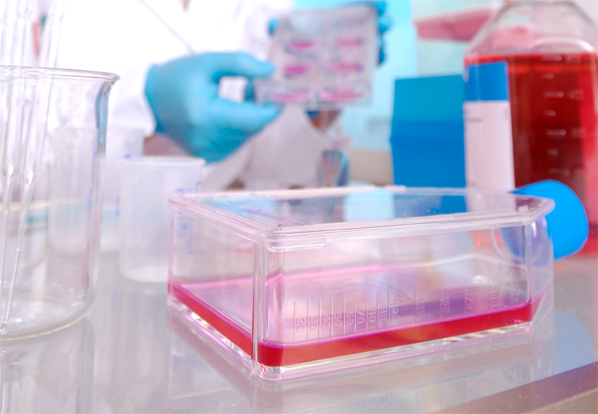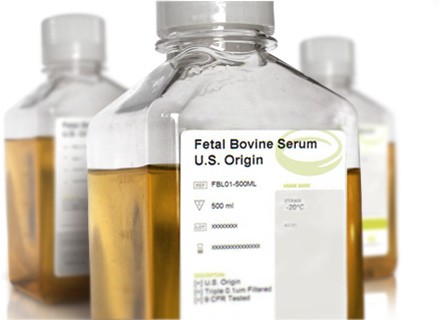Today, with standardized media and sophisticated incubation conditions, culturing animal cells is considerably easier than it used to be. Since 1950s, tissue culture media were developed and conditions were worked out which closely simulate the situation in vivo. In particular, the environment is regulated with regard to the temperature, osmotic pressure, pH, essential metabolites (such as carbohydrates, amino acids, vitamins, proteins and peptides), inorganic ions, hormones and extracellular matrix. Among the biological fluids that proved successful for culturing cells, serum is the most significant. Five to twenty percents of serum is usually added to media for optimal cell growth. Serum is an extremely complicated mixture of compounds including undefined components, therefore much work has gone towards creating a chemically defined alternative to serum.
A wide variety of culture media is currently available. The choice of culture media is dependent on the requirements of cells. The components of suitable culture media include:
The most basic media are balanced salt solutions (BSS), e.g., phosphate-buffered saline (PBS), which may be used for washing cells and for short incubations in suspension. More complex defined media are used for growth and maintenance. Defined media can also vary in complexity, by the addition of a number of constituents, e.g., from Eagle’s minimum essential medium (MEM) which contains essential amino acids, vitamins and salts, to McCoy’s medium, which contains a larger number of different amino acids, vitamins, minerals and other extra metabolites (such as nucleosides).

A number of supplements to the basic media are necessary to enable them to be used for culturing cells. Cel cultures have an optimum pH for growth, generally between pH 7.4- 7.7. The type of buffering that is used for the media depends on the growth conditions. When cells are incubated in a CO2 atmosphere an equilibrium is maintained between the medium and the gas phase. A bicarbonate−CO2 buffering system is most often used due to its low toxicity towards the cells. HEPES, a much stronger buffer, may also be used, however, in this case much greater concentrations of HEPES than bicarbonate are required when used in a CO2 atmosphere.
Each type of media has a recommended bicarbonate concentration and CO2 tension to achieve the correct pH and osmolarity. Nevertheless, this may vary slightly among laboratories, therefore, a sample of media should be left under the normal incubating conditions and monitored overnight, the buffering can then be adjusted accordingly.
HEPES buffer should normally be used in conjunction with bicarbonate for which a relationship between the HEPES and bicarbonate exists for differing CO2 levels, although, HEPES alone can maintain pH in the absence of exogenous CO2. The addition of 1-5 mM pyruvate to the medium increases the endogenous cellular production of CO2 and limits the need for a CO2 atmosphere. Some defined media have been devised for this purpose, e.g., Leibovitz L-15 medium. Cells which produce large amounts of endogenous CO2 under certain incubation conditions may require HEPES to buffer this CO2 product.
The density of the culture may affect the CO2 requirement, however, in general phenol red in the medium will indicate the state of the pH at any given time.
In addition to buffering the medium, there are other growth requirements including amino acids, the requirement for which may vary with cell culture type. Commonly the necessary amino acids include cysteine and tyrosine, but some non-essential amino acids may be needed. Glutamine is also required by most cell lines and it has been suggested that cultured cells use glutamine as an energy and carbon source in preference to glucose, although glucose is present in most defined media. Glutamine is usually added at a final concentration of 2 mM, however, once added to the medium the glutamine is only stable for about 3 weeks at 4 °C.
Although there is much research aimed at attempting to reduce the requirement of cells for serum, by alternative supplementation of the media, it is apparent that most cell lines still require serum for adequate growth. Various sources of serum may be used such as calf, fetal calf, and horse. Many continuous cultures utilize calf serum, but often fetal calf serum provides the best growing conditions. The level of serum used depends on the particular cell line and should be determined empirically.
Batches of serum may vary considerably in their ability to support cellular growth. It is therefore important to test batches of serum and have sufficient quantities of a batch that shows suitable growth supporting characteristics stored at -20 °C. To check these properties, cloning efficiency and growth characteristics (morphology, growth patterns) should be carried out over a concentration range of 2% to 20% serum. This wide concentration range will disclose if the alteration in the concentration of serum is possible to give optimal growth characteristics for a particular cell line.

Unless good sterile conditions can be maintained (e.g., using laminar flow hoods) it is necessary to incorporate antibiotics and antimycotics into the media. A wide range of suitable preparations are available from relatively specific antibiotics, e.g., penicil- lin/streptomycin solutions, to broader spectrum antibacterial/antimycotic agents such as kanamycin or amphotericin B. The antibiotics chosen should clearly not to be toxic to the cells in culture and may depend on the type of contamination experienced in the individual laboratory.